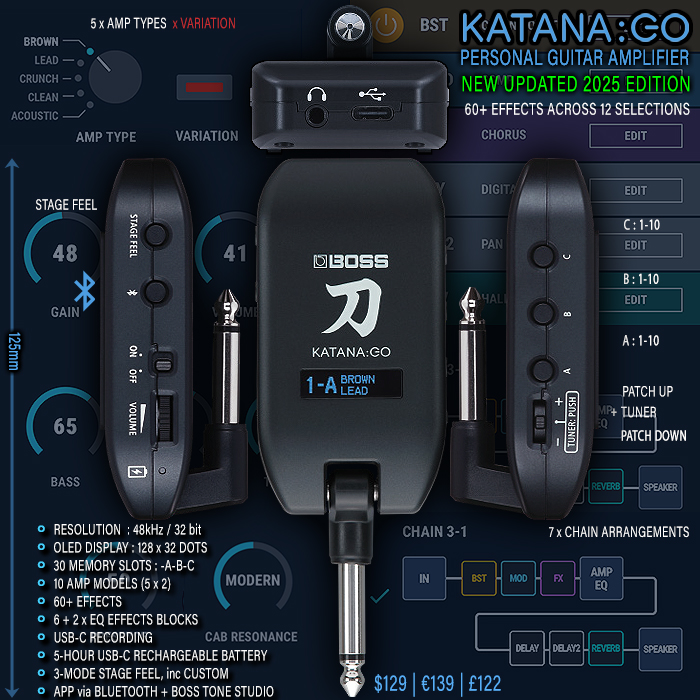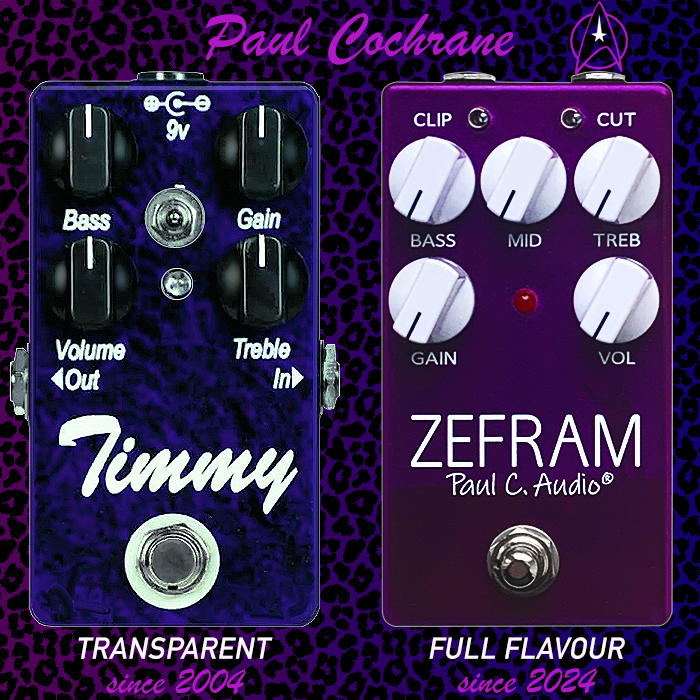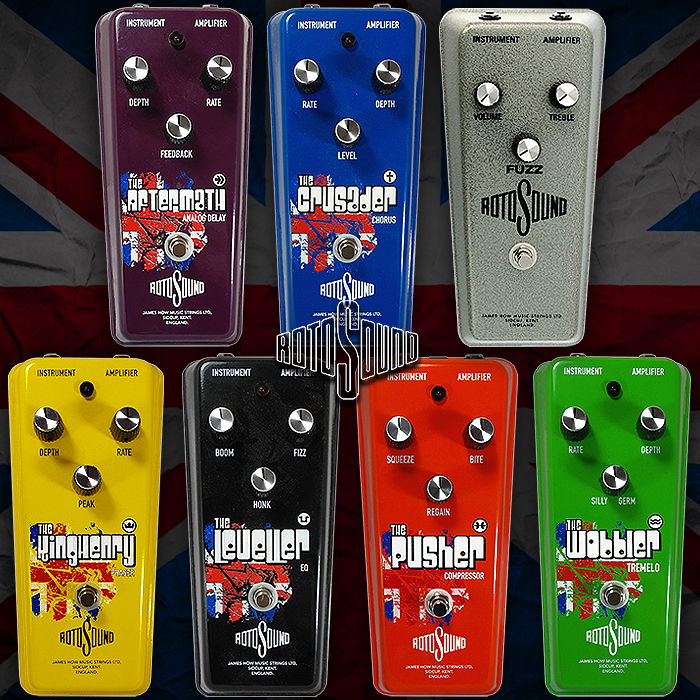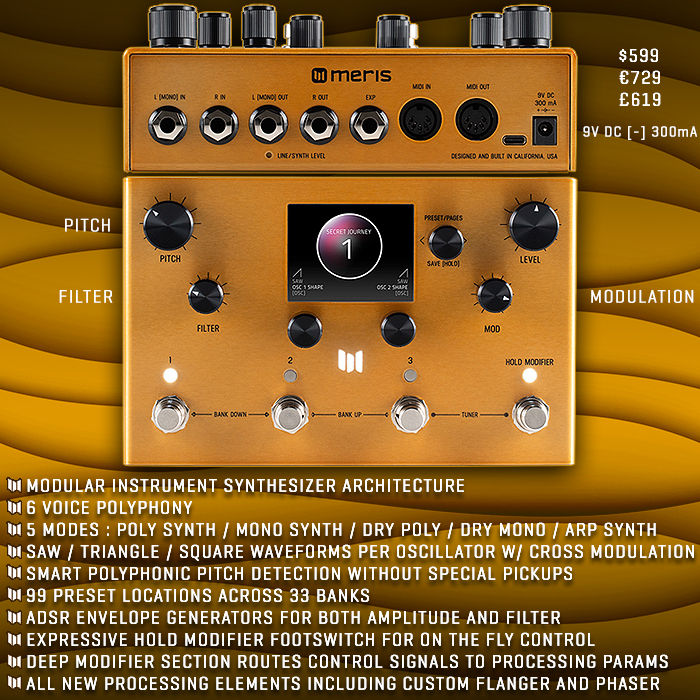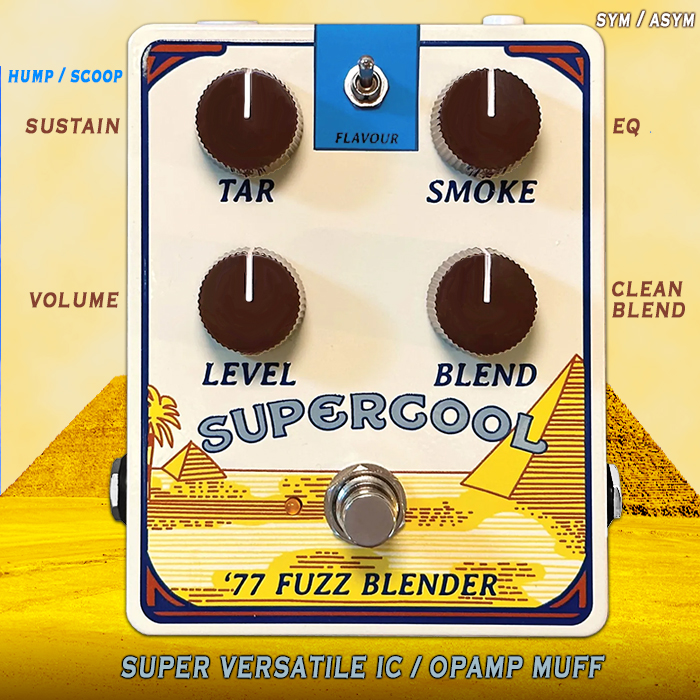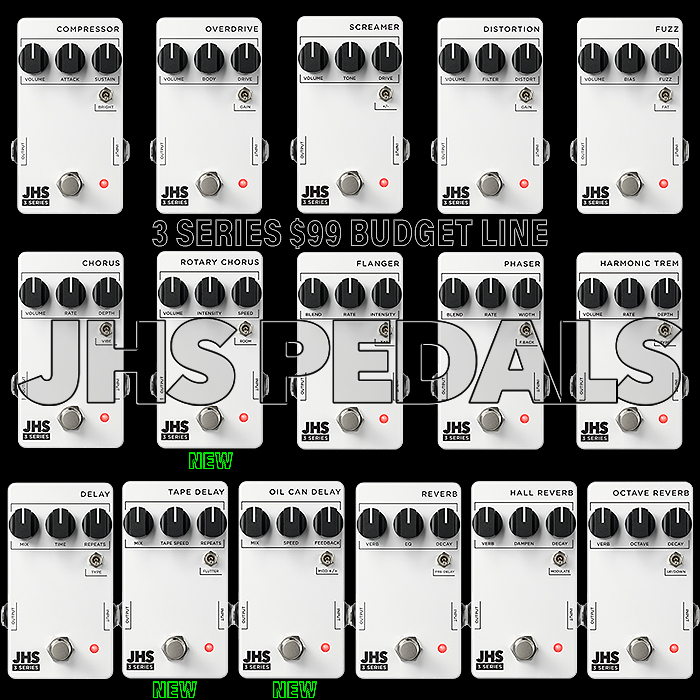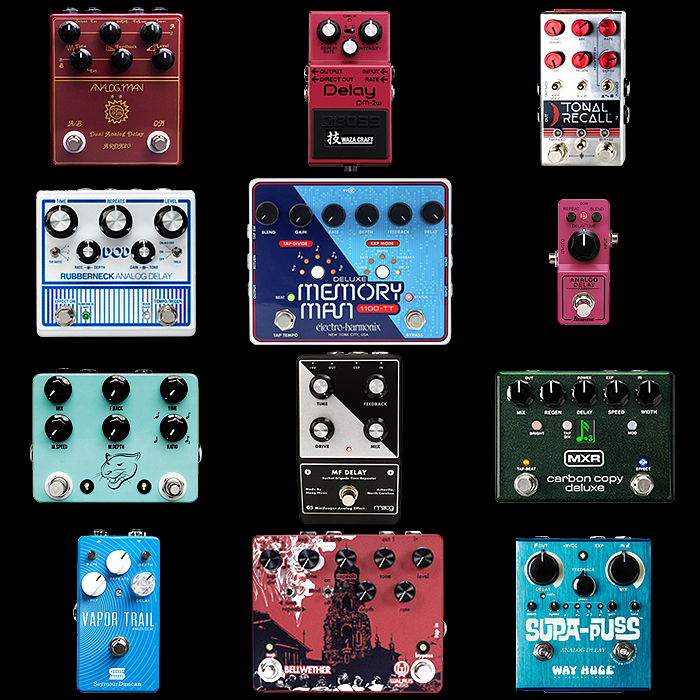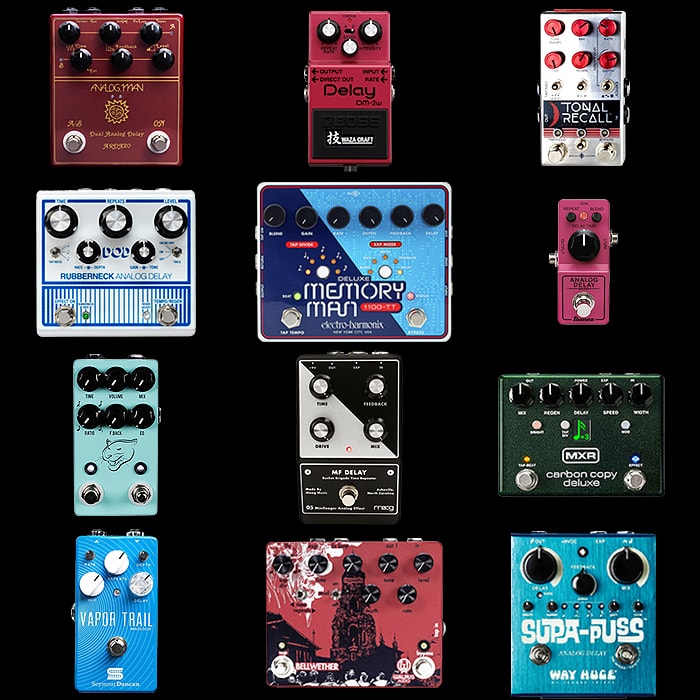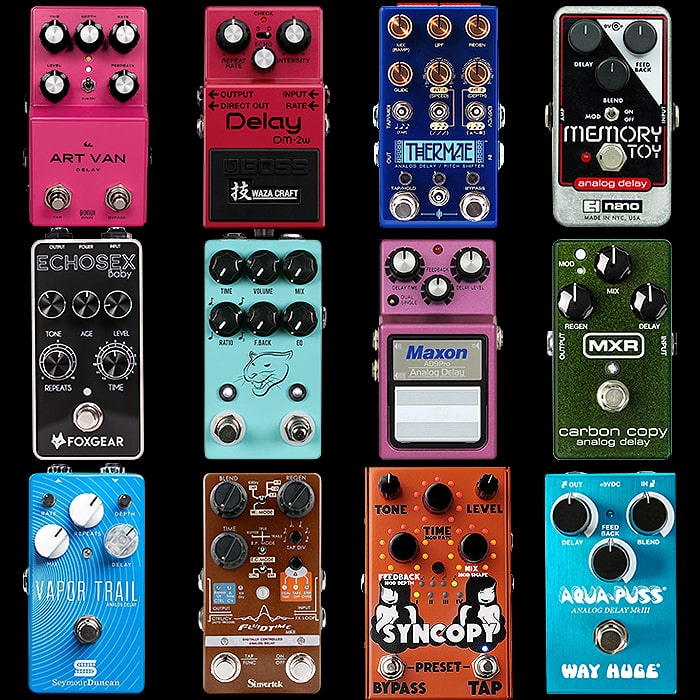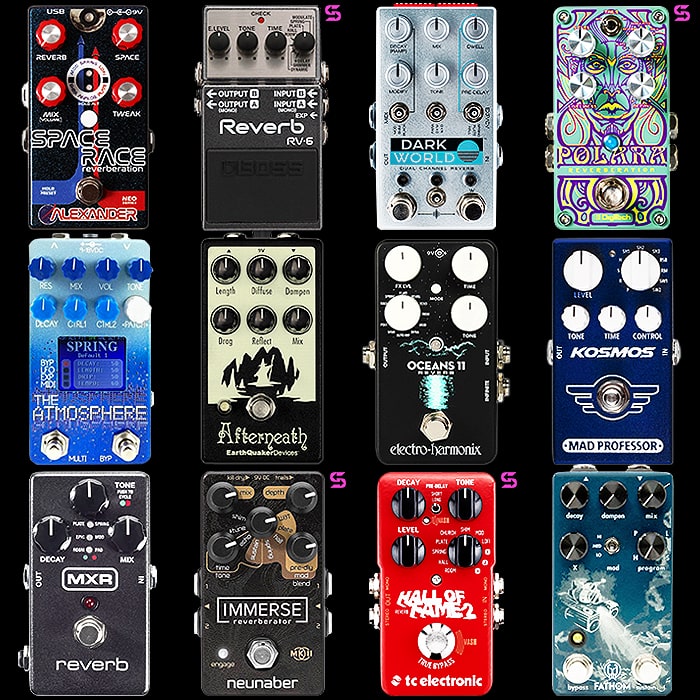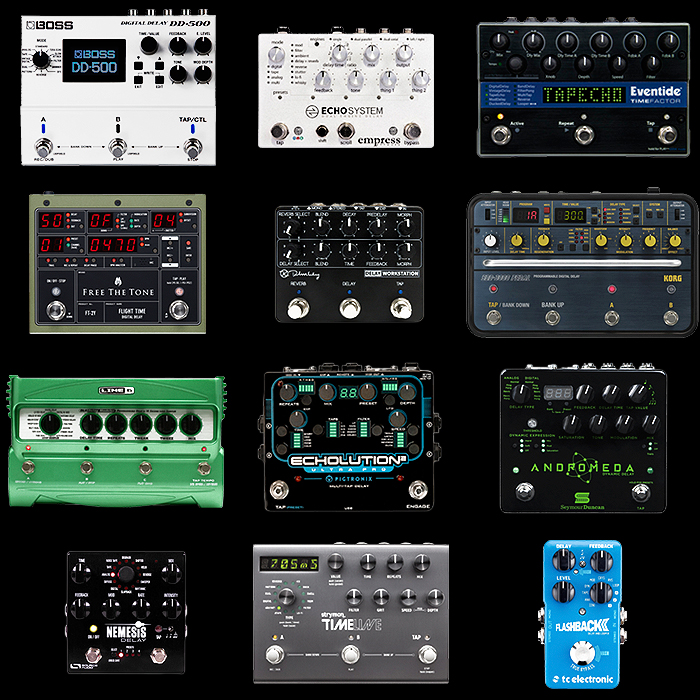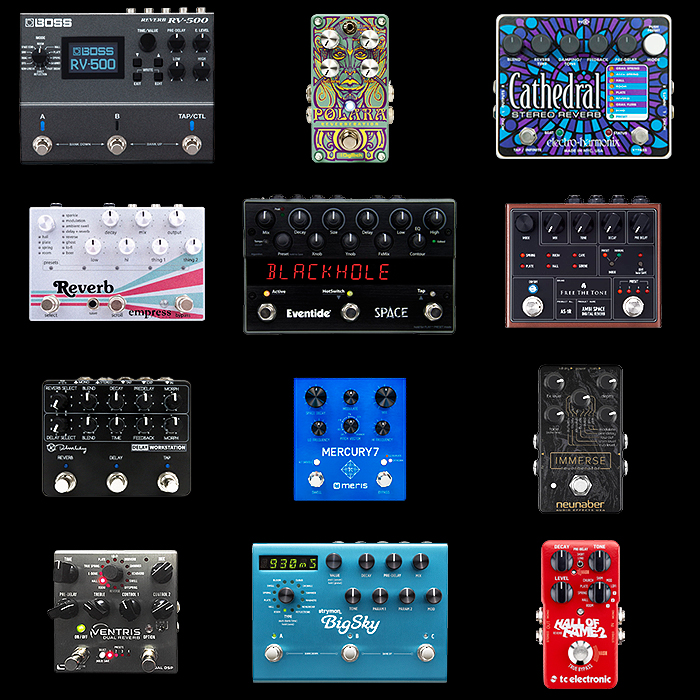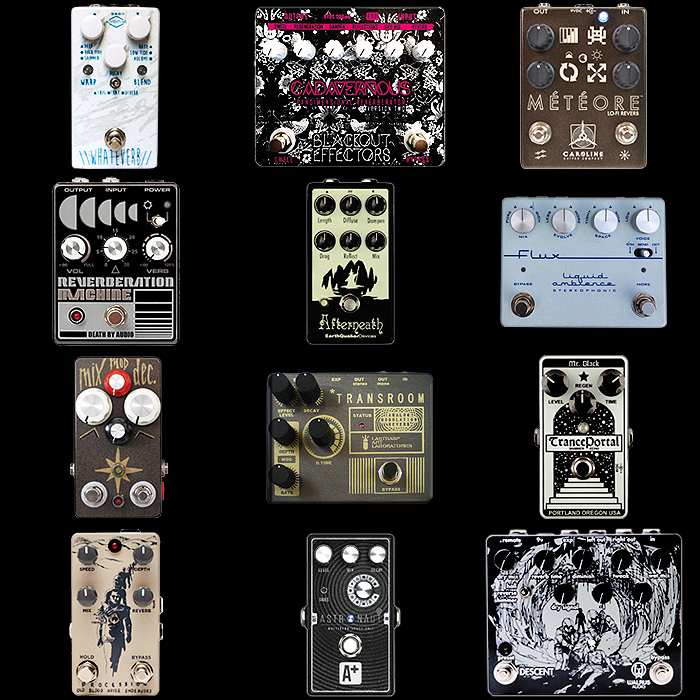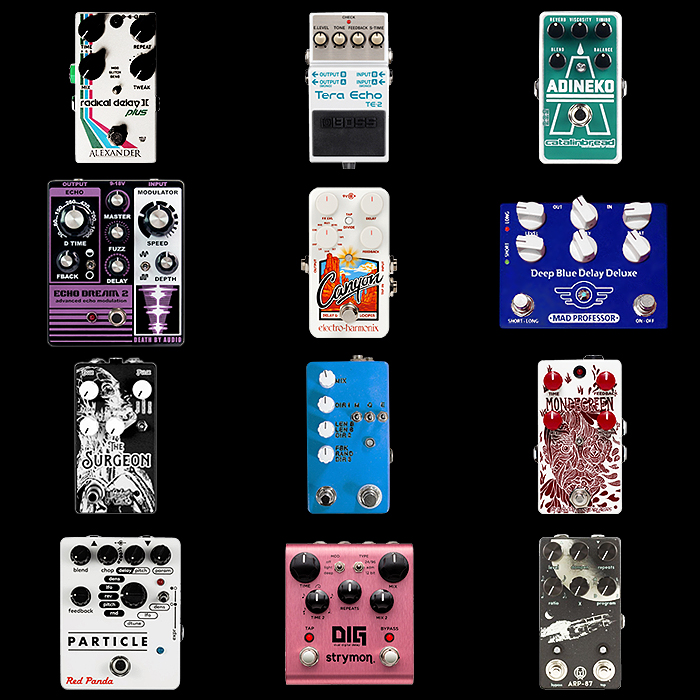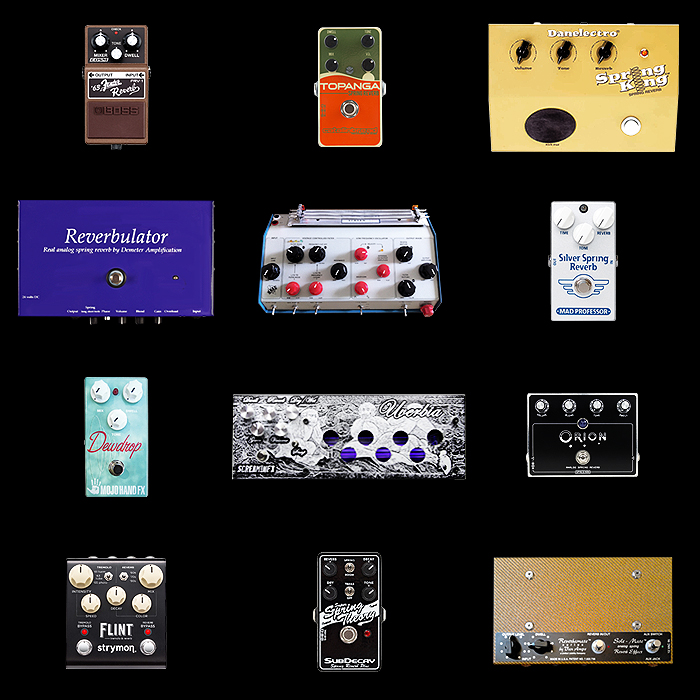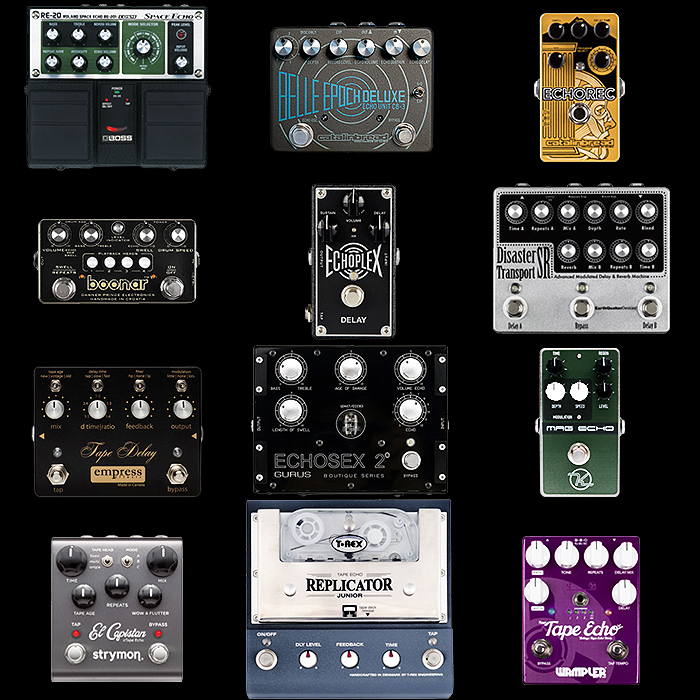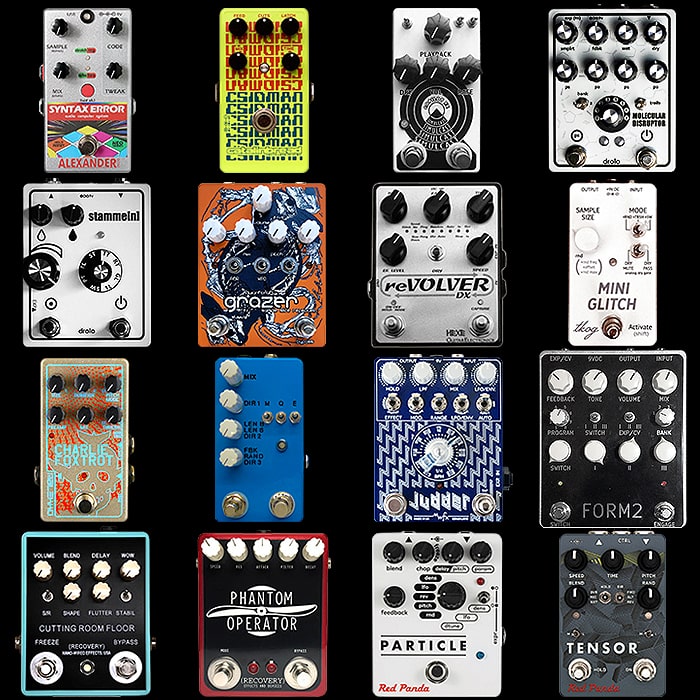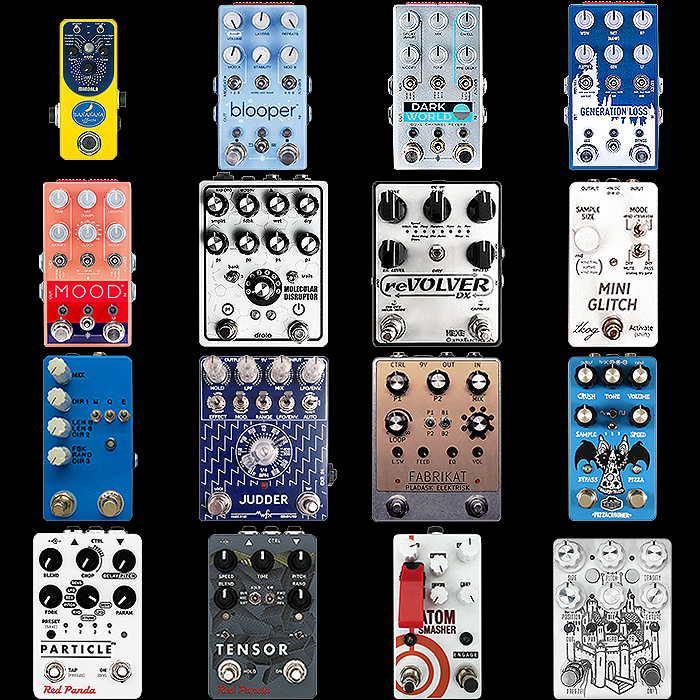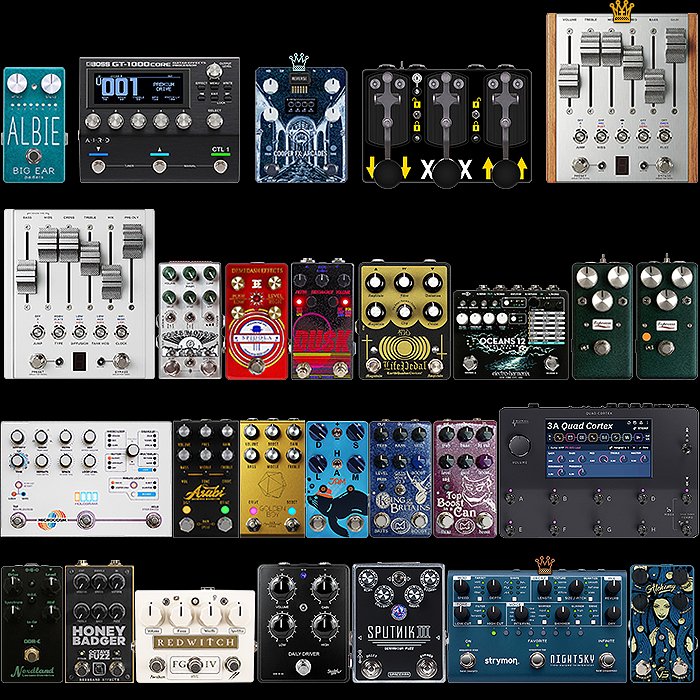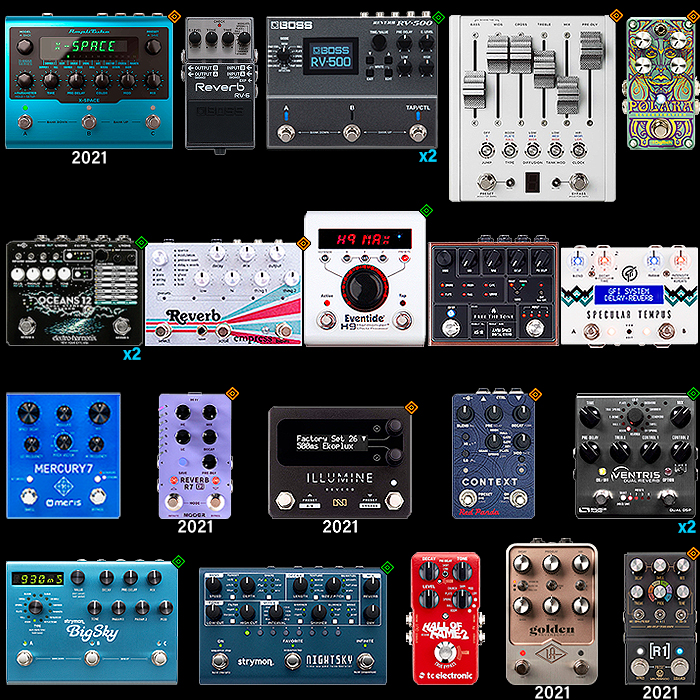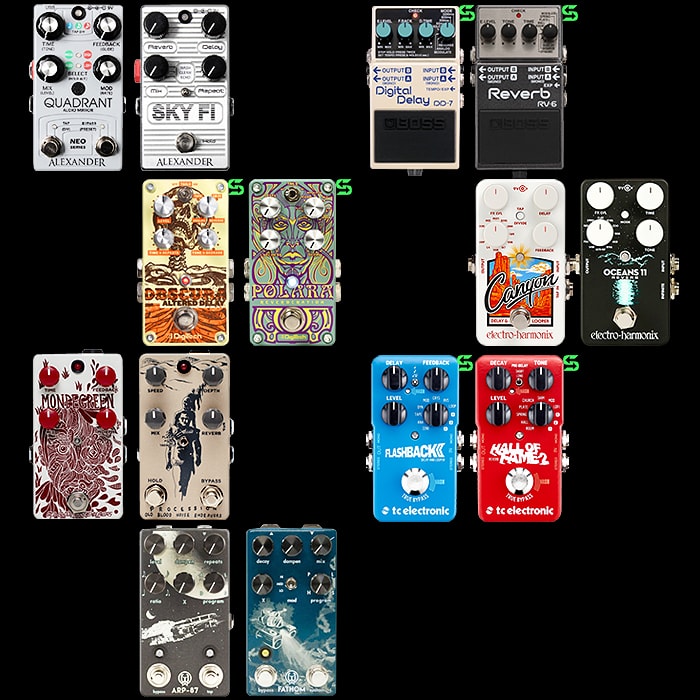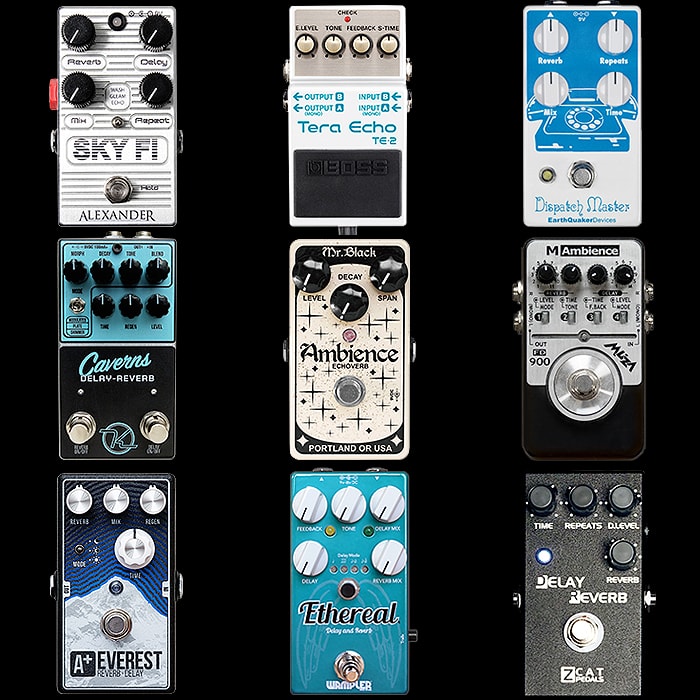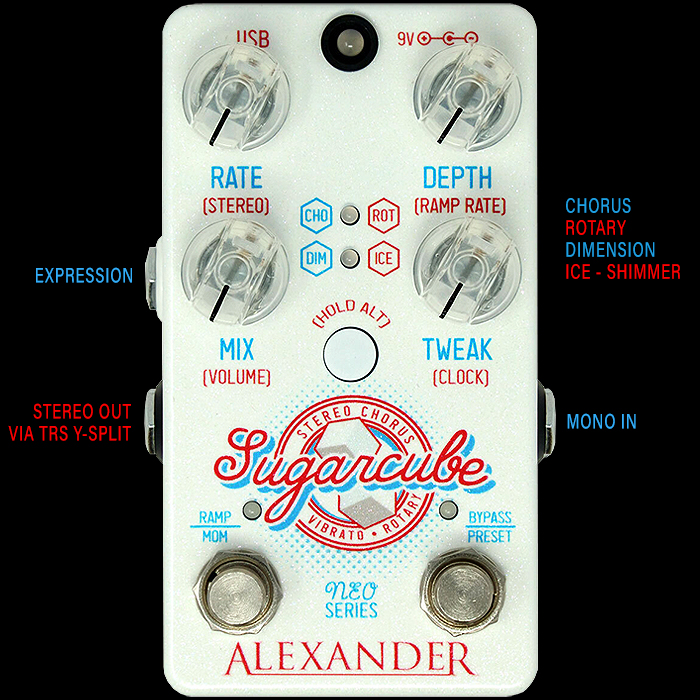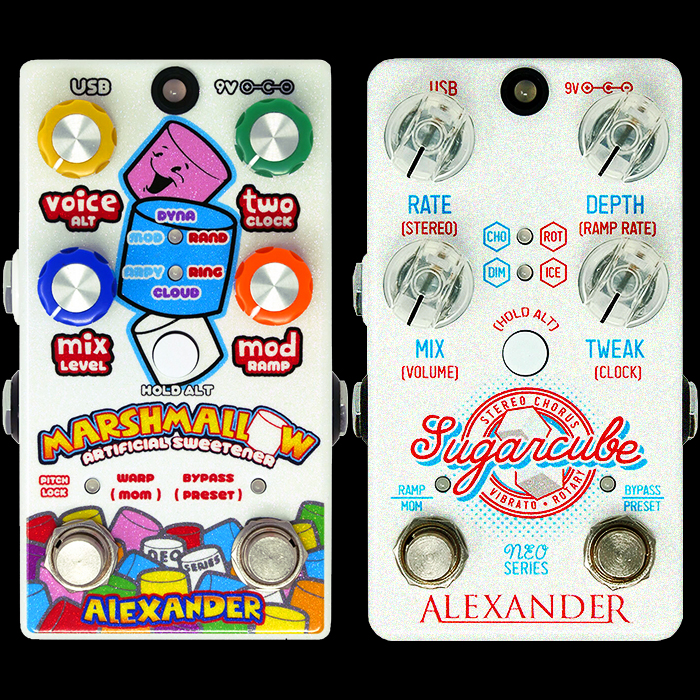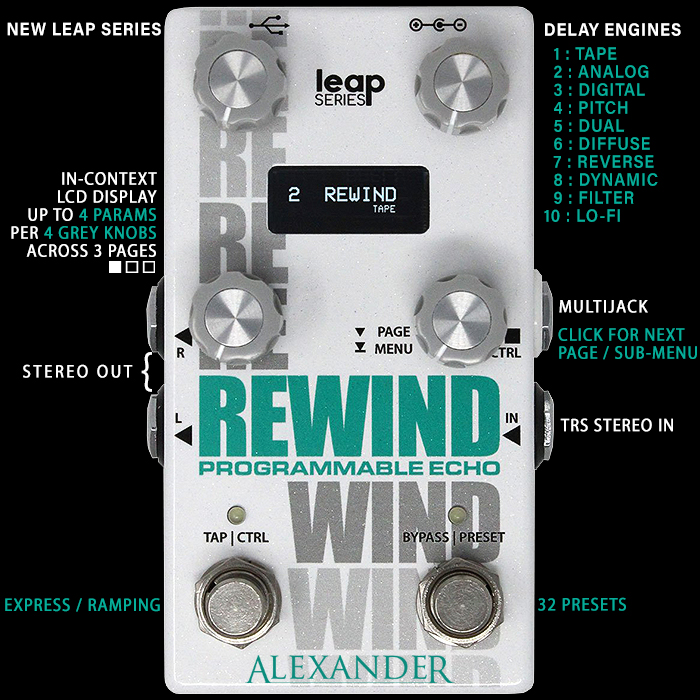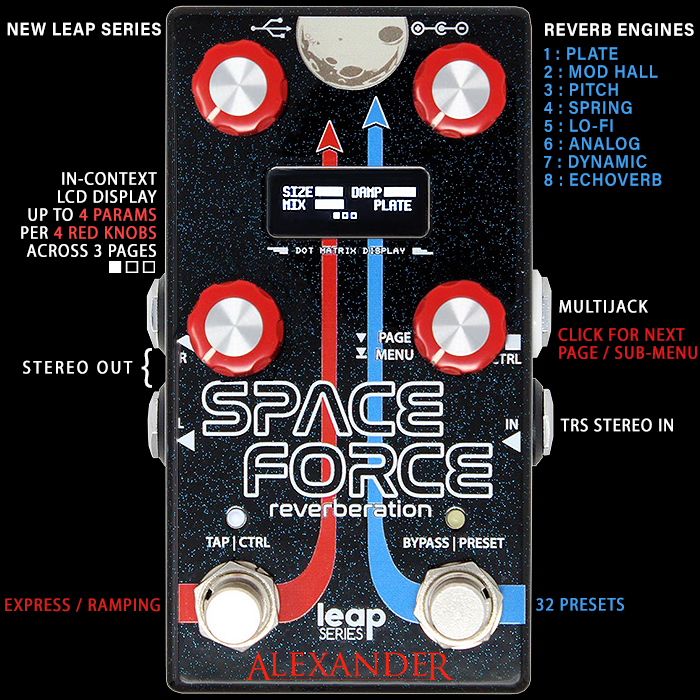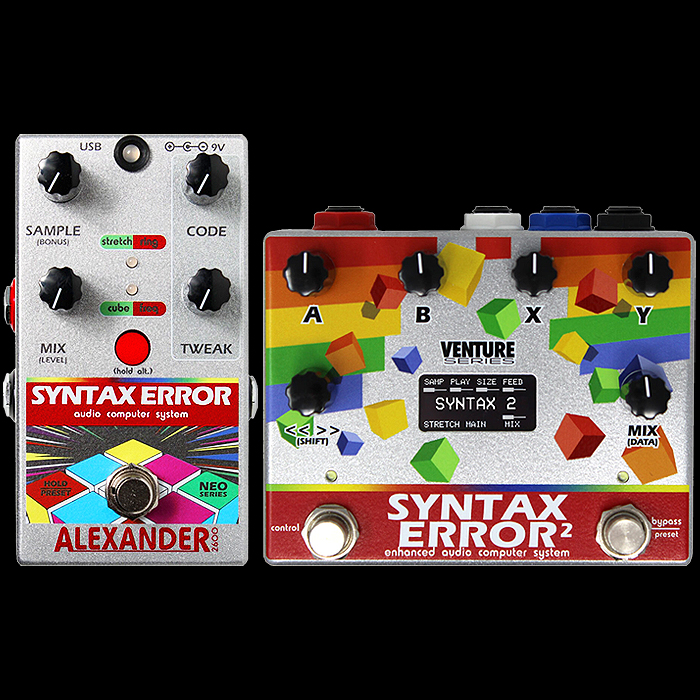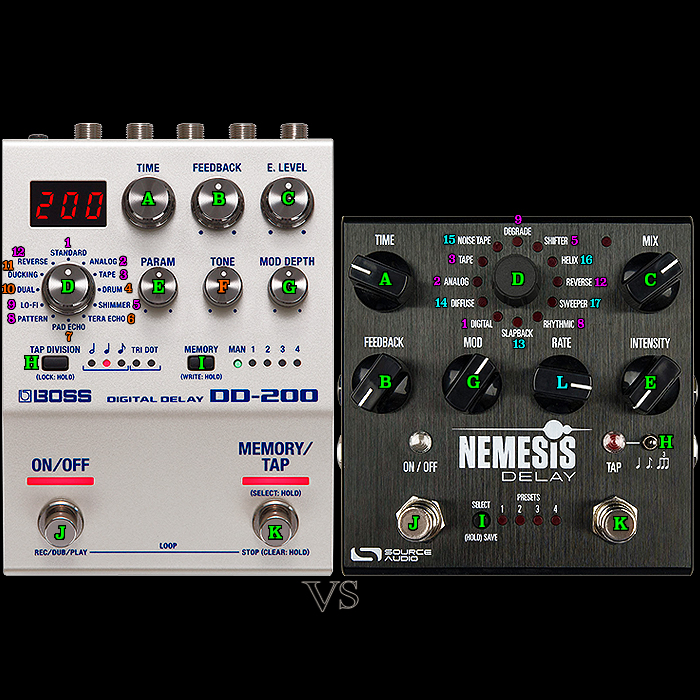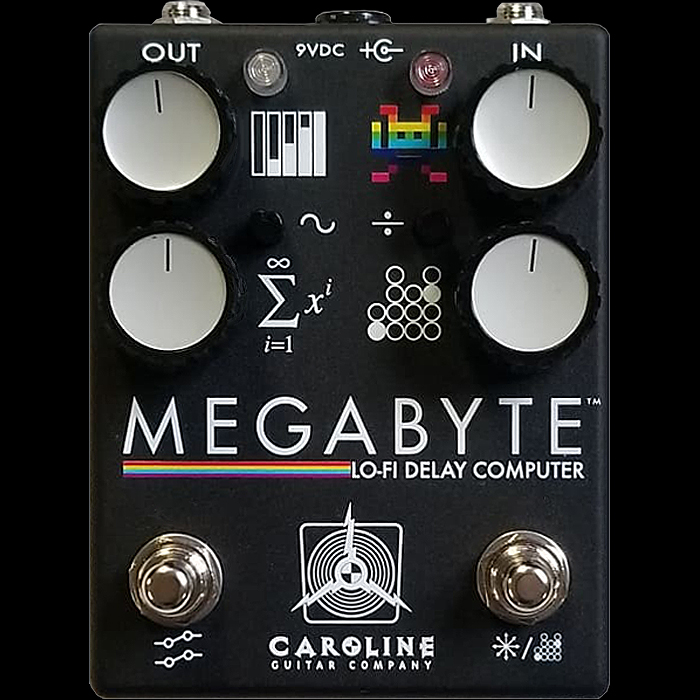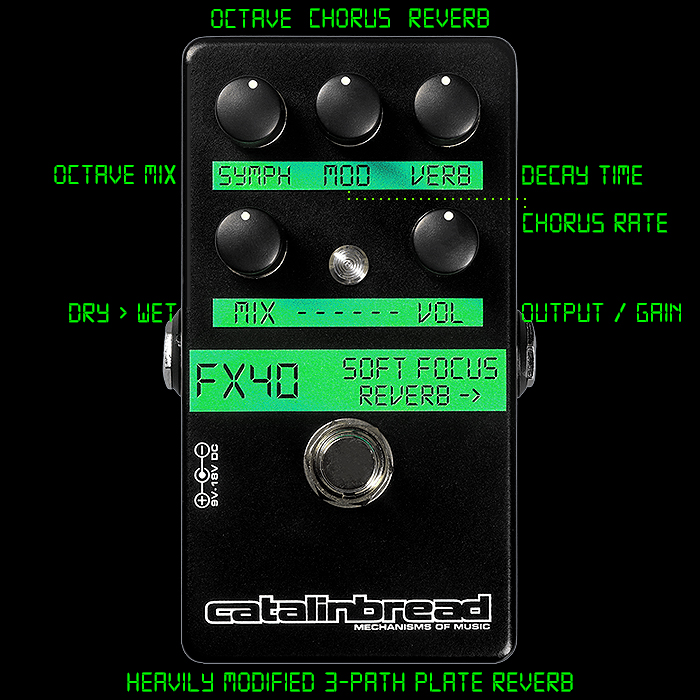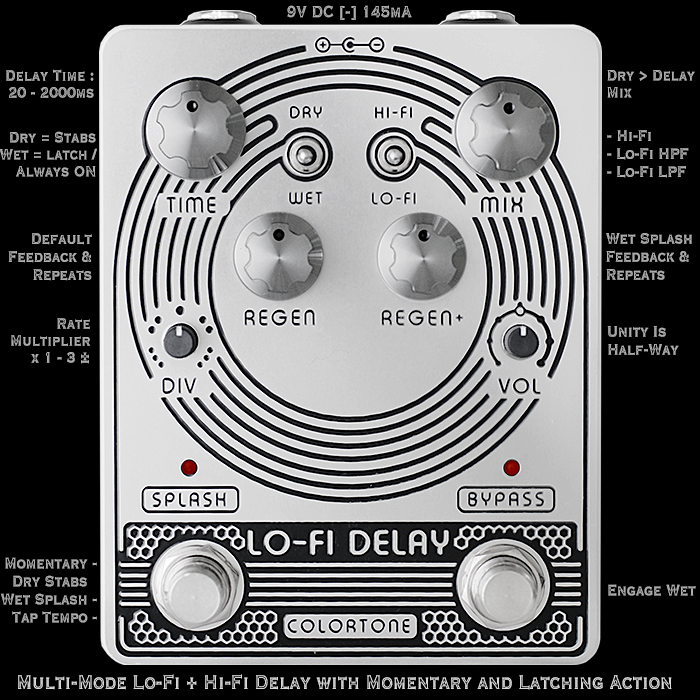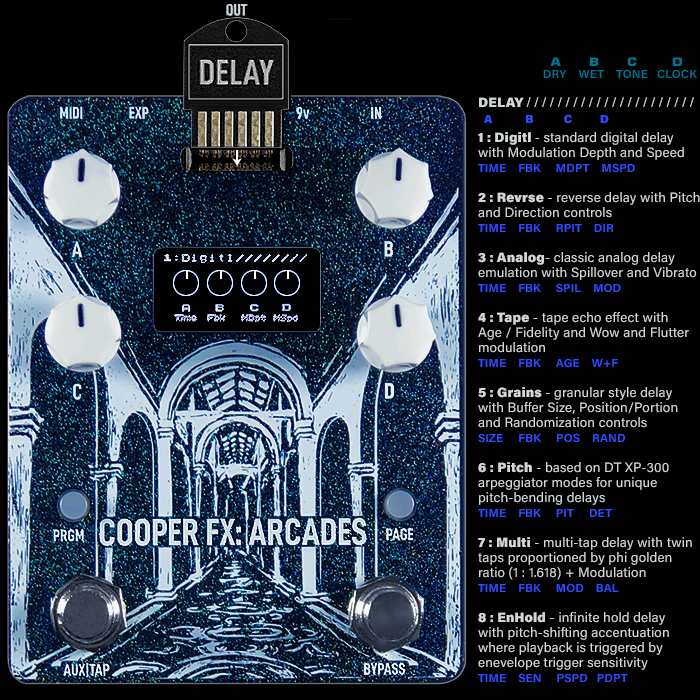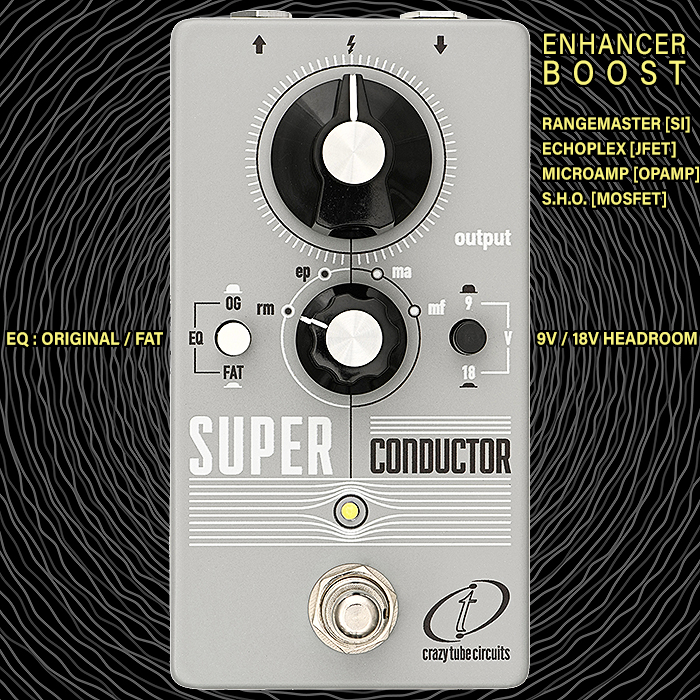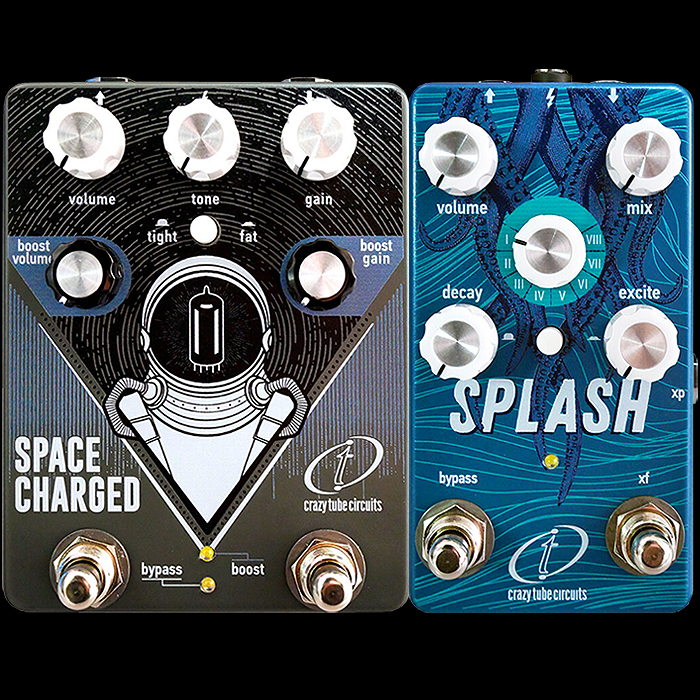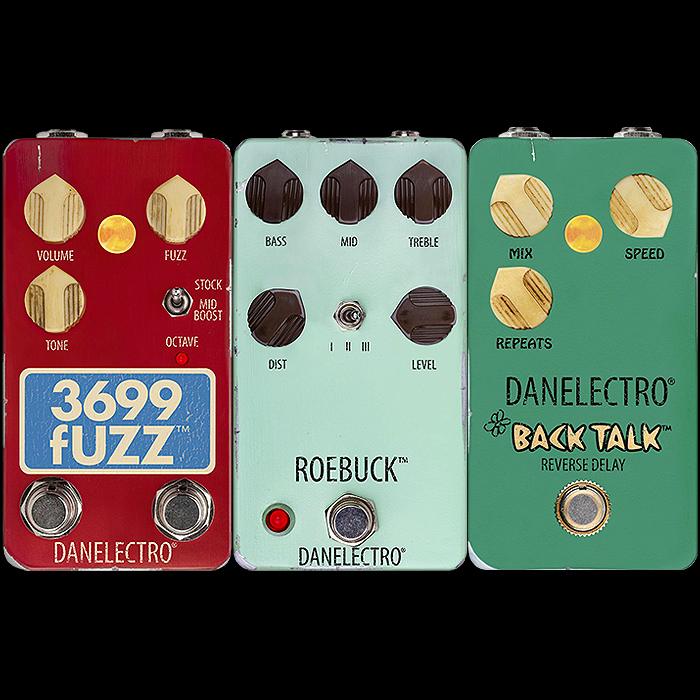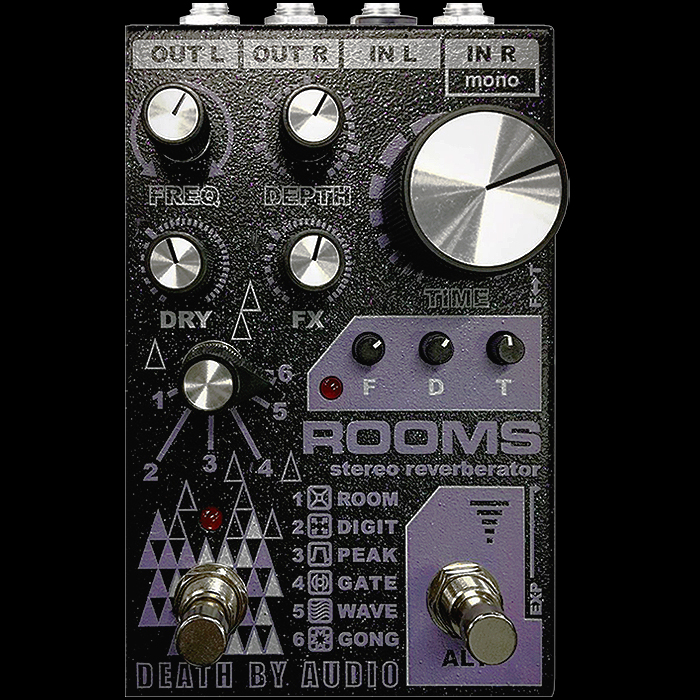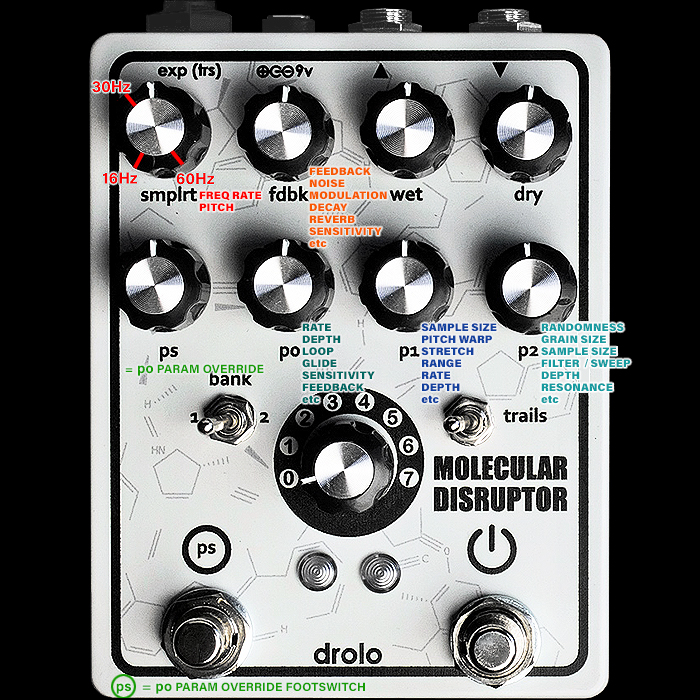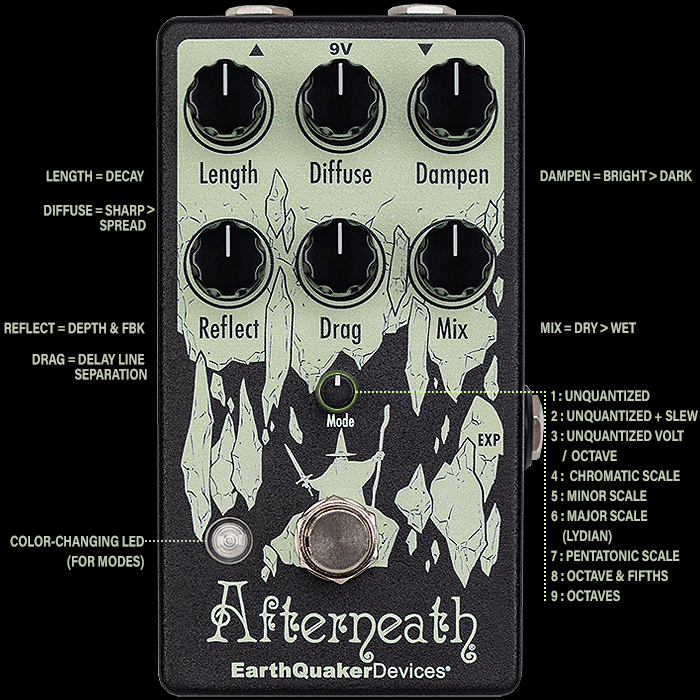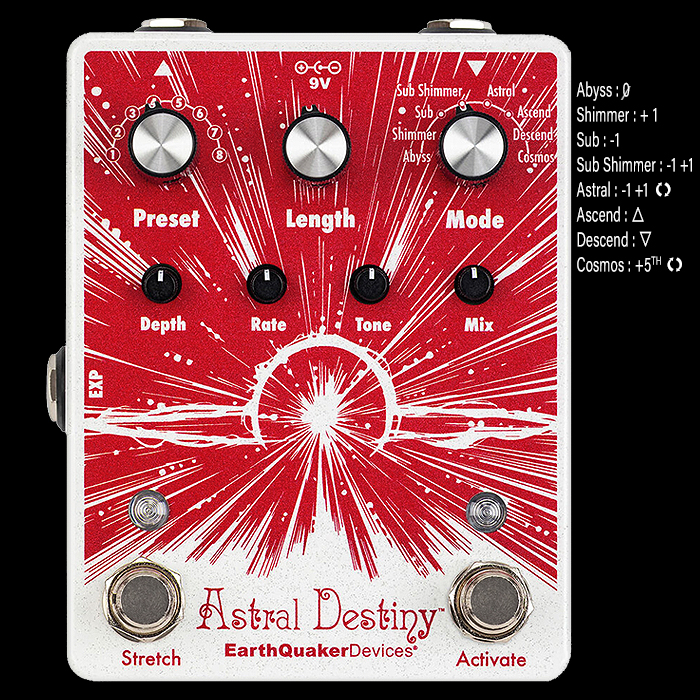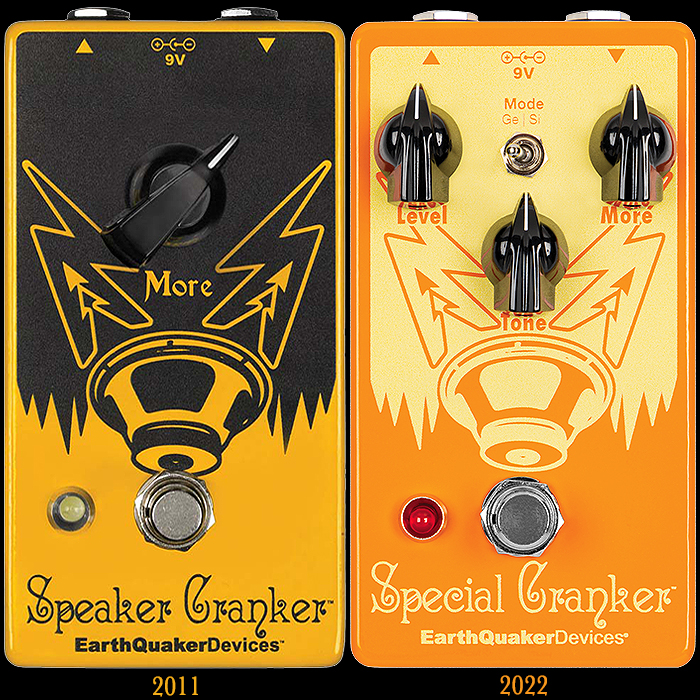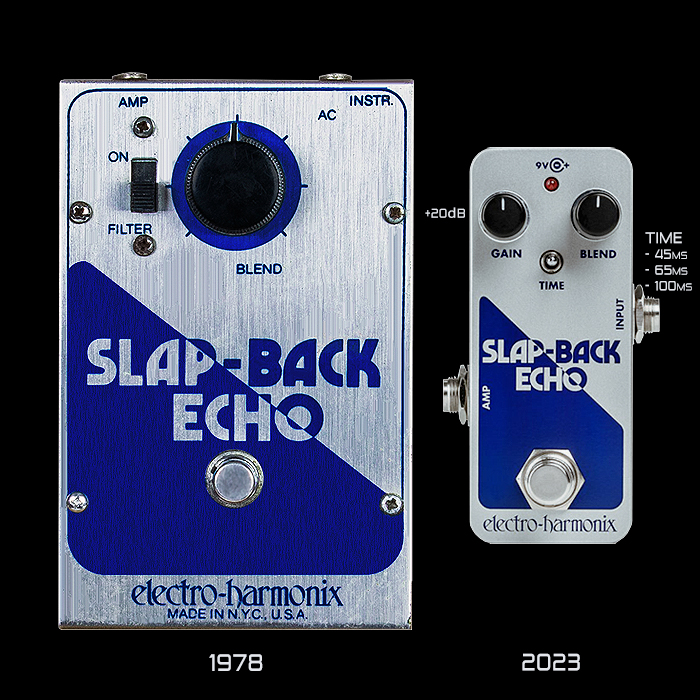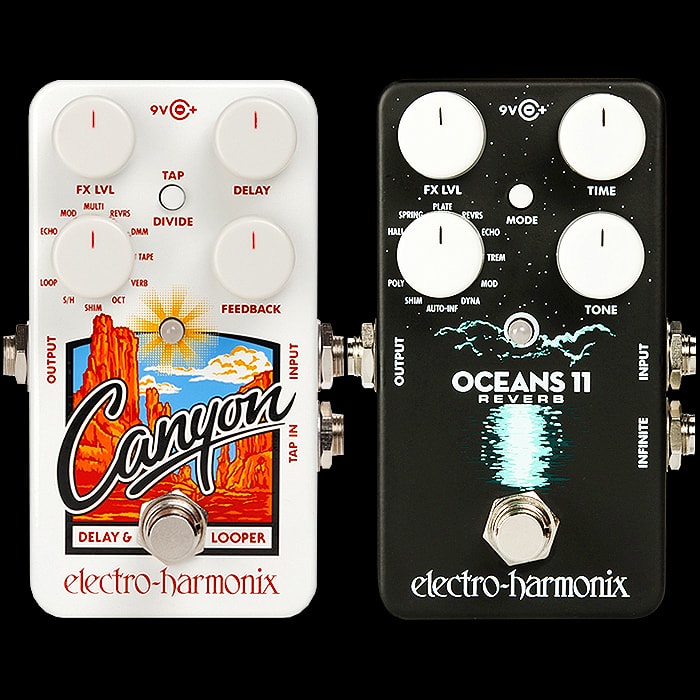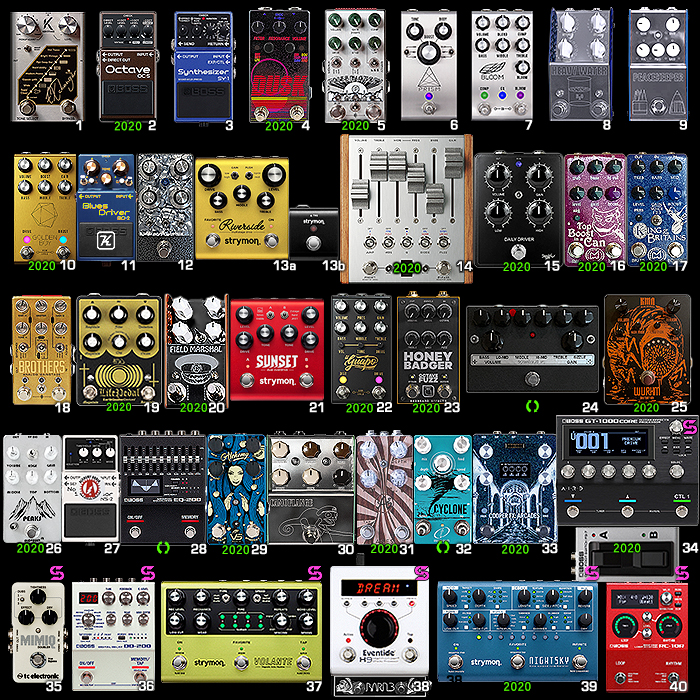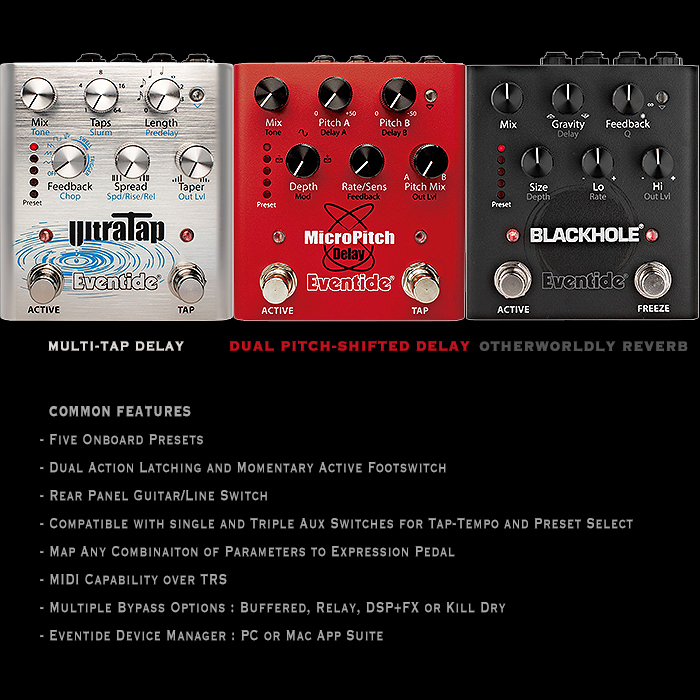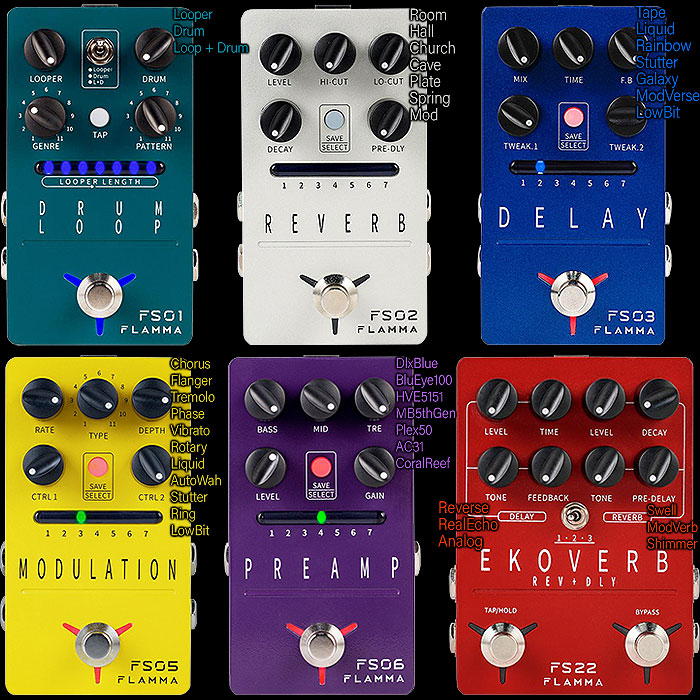2020 Best of New Delay and Reverb Pedals for the Year (Exc. Reverb Workstations)

The third in my 2020 roundup series covers interesting and innovative Delay and Reverb Pedals released during the year, while it excludes the bigger Reverb Workstation Pedals - which I already featured back on November 30th. In that article I declared 2020 to be the ’Year of Reverb’ - as there have been so many quality releases in that genre.
Here we deal mostly with compact and medium variants with slightly fewer modes and parameters, but not necessarily entirely. The one pedal that puts in a repeat appearance here is the Flamma FS02 Reverb - obviously to complete that set.
I actually own none of these pedals (yet?) - while I’ve indicated that several of these are on my wishlist - including the Flamma and Mooer trios. In my own chain I have a number of pedals to cover this territory - including the Cooper FX Arcades, Boss GT-1000 CORE, Boss DD-200, Strymon Volante, Eventide H9 Max and Strymon NightSky - nearly all of those are stereo. So any pedals listed here would be secondaries, understudies, alternatives and auxiliaries for me any my particular rig. And because of the nature of my pedal-chain I have limited tolerances for pedal footprint / size too - and a mandatory requirement for everything in the second half of the chain to be stereo obviously - which rules out a number of the candidates listed in this roundup.
I do nevertheless appreciate the innovations on display here, and how players with more typical mono rigs may be able to make best use of these. I’m heartened to see the development of compact, extended featured, preset-enabled stereo pedals - as pioneered by Keeley courtesy of its Eccos Flange-Modulated Delay and Looper (2019), and this year’s Walrus Audio Mako Series D1 High Fidelity Echo Machine in particular.
Pedals are listed alphabetically by brand :
Alexander Pedals History Lesson Vol. 3 Delay - $199/£199
I keep saying I should really have more Alexander Pedals than the 3 I've acquired to date - they really do make some fantastic extended-feature and smartly engineered pedals - while I really need more of these to feature stereo output to be properly compatible with my rig.
The 3rd iteration of the History Lesson Dealy Pedal has refined its delivery to the max really - and has produced a fantastic full-featured 6-Mode delay with extended configuration abilities.
The 6 Delay Modes are :
- MAG : Magnetic tape-flavored echo
- BBD : Solid-state analog delay
- DIG : Squeaky-clean digital delay
- LOFI : Dirty analog delay
- 4HD : Four-head tape echo
- FLT : Filtered 12-bit rack-style delay
As an Alexander Neo Series Pedal - it provides by default 4 Presets, Neo Morph function via NEO footswtich, Tap-Tempo, Auto-Trails, and Secondary/Alternative Parameters.
I still feel that the Keeley Eccos and Walrus Audio D1 are probably one step ahead - particularly for their stereo output. But if you're Mono only - then this is a really great proposition, and well worth considering.
Crazy Tube Circuits Splash MK4 Reverb - €199/£199
The Splash MK4 topology here is very familiar to me as it is pretty much identical to the CTC Cyclone Phaser that I have.
It has 4 main controls alongside an 8-position rotary Mode Selector :
- Ambient / Spacious Pad Effect
- Moderate Sized Reverb - from Spring to Room to Hall
- Large Reverb - from Hall to Ambient
- Plate Style Reverb
- Shimmer - High Pitched Harmonics
- Modulated - Faster Spinning Extra Long Decay
- Modulated - Long to Infinite Decay
- Flanged Freeze Reverb - Short to Infinite Decay
The 4 control knobs are - Volume, Mix, Decay and Excite - the last parameter of which changes slightly for different Modes.
Few compact Reverbs have 8 different modes and dual footswitches for further dynamic playback - this is another worthy contender.
Danelectro Back Talk Reverse Delay - $160/£160
As reported - prices have dropped across the board for these recently so they are an even better proposition now.
This is a reproduction of a classic earlier Danelectro pedal of the same name, and is widely regarded as the benchmark stand-alone Reverse Delay. I actually have 4 of the 5 recent Danelectro pedals - with this being the only straggles to date. I wasn't sure I needed this as I have several Reverse Modes on my Cooper FX Arcades in particular - but I've kind of warmed to it really - while I don't know where I would necessarily fit it in on my rig.
It has 3 simple controls - Mix, Speed, and Repeats - it really could not be more simple and elegant and is actually quite wonderfully musical too.
This is by no means a priority for me, but I think I will likely snap one up eventually if/when I can get it for a sufficiently appealing discount - file under 'nice-to-have' rather than essential.
Earthquaker Devices Afterneath V3 Otherworldly Reverberator - $200/£200
This was a really impressive early Reverb pedal release all the way back at Winter NAMM this year - and with its many refinement and added 9 Quantizing, Scale, and Octave Modes it was a genuine frontrunner for me for a while.
But then the EHX Oceans 12 launched, and Cooper FX's Arcades, Strymon's NightSky, and of course Chase Bliss Audio's CXM 1978 - which all kind of left the Afterneath somewhat overshadowed and quite a few notches further down my wishlist.
With its 7 controls - Length, Diffuse, Dampen, Reflect, Drag, Mix and mini 9-Modes knob it is for sure a powerful ambient reverb, but it's not stereo - and in considering this against the CBA Dark World which I have not yet pulled the trigger on either - I can't decided if I would use either in my rig.
They would only be on understudy duties in any case as sort of ambient texturisers - but I have lots of options in those areas already. I'm sure many will find great use out of this in their rigs, while I'm not sure it really fits that well into mine!
Flamma FSO3 Stereo Delay - $68/$88
Here we have the Flamma 7 Mode Stereo Delay :
- Tape
- Liquid
- Rainbow
- Stutter
- Galaxy
- ModVerse
- LowBit
This time around the 6 controls are : Mix, Time, Feedback, Tweak 1, Tweak 2, and of course the usual push-button Save/Select.
This is another really great prospect - with stereo output and 7 presets onboard too.
Flamma FS02 Stereo Reverb - $68/$88
And so to the first of the Flamma Pedals - which I covered very recently, so no point in duplicating all that detail here.
We essentially have 6 controls - Level, Hi-Cut, Lo-Cut, Decay, Pre-Delay and the usual Save/Select button.
And the 7 Modes are :
- Room
- Hall
- Church
- Cave
- Plate
- Spring
- Mod
All in glorious Stereo and with 7 Presets available too - 1 per Mode as such.
This is obviously a budget pedal - but it's a budget pedal with extra bells and whistles galore and it actually sounds pretty darn good - I'm not the biggest advocate of budget pedals really, but I really rate Flamma and Mooer in particular. This is genuinely innovative and something quite different at this size and price-point. Super easy usability too!
Flamma FS22 Stereo Ekoverb Reverb + Delay - $88/$128
The first released Flamma pedal isn't quite as appealing for me, as it lacks the essential presets of the others - and only really has 3 Modes to it :
- Reverse Delay + Swell Reverb
- RealEcho Delay + ModVerb
- Analog Delay + Shimmer Reverb
You then have 2 banks of 4 controls per side - Level, Time, Tone, and Feedback for Delay; and Level, Decay, Tone and Pre-Delay for Reverb.
Finally you get 2 footswitches on this occasion, with the right-hand one being the regular Standby On/Off switch, and the left-hand one is a Tap-Tempo input, and Hold/Freeze for the Reverbs.
As I said in my original review - this is somewhat the least flexible of the Flamma pedals, but it sounds great and works really well with a very engaging stereo soundstage. This is in some ways the least appealing of all the Flammas for me - but I can understand its popularity and appeal vs something like and EQD Avalanche Run.
Horizon Devices Flux Echo Stereo Reverb and Delay - $200/$200
Horizon Devices' fourth pedal as such as far as I'm aware - is a very credible Stereo EchoVerb pedal with 3 Reverb + Delay Combination Modes :
- Ambient Reverb + Analog Delay
- Modulated Reverb + Reverse Delay
- Shimmer Reverb + Tape Echo
There are 4 control knobs, 2 of which have alternative parameters - Mix, Tone, Reverb|Decay, and Delay|Feedback.
You have Tap Tempo here too and a Freeze/Hold function on that same footswitch.
This for me is a slightly more appealing version of the Flamma FS22 Ekoverb - just a little more compact and practical.
It's another pedal I don't need and am not likely to acquire - but I'm really impressed with its elegant execution here.
Jam Pedals Delay Llama Extreme Analog Delay - €329/£300
JAM Pedals' most fully-featured analog delay to-date has all kind of hidden extras - including 4 modulation modes onboard :
- Vibrato (1 Preset LED) - Sine-wave LFO modulation
- Tape-age (2 LEDs) - Slight and Random pitch variations
- Random (3 LEDs) - Random changes to the ms value of the repeats over fixed time increments resulting in abrupt pitch and rhythmic changes
- Pitch-shift (4 LEDs) - 5 distinct pitch-shifted intervals and 5 playback patterns, the last of which is a 5-mode sequencer
You get the 3 typical control knobs - Time, Repeats, and Level - where additional dots around the R and L dials indicate further mode variations. There's 3 toggle-switches in the centre, including tap-divisions. And you have 4 sort of footswitches including a tap-tempo one.
This takes the JAM Pedals Analog Llama Delay into some very interesting territory, but my pal Matt reports that you need to careful that the modulations don't overwhelm, as they tend to have quite a strong flavour.
I admire everything this pedal delivers - in fact JAM Pedals have just introduced the CTRL Box add-on for the Extreme - while it does somewhat over-extend an already significantly large footprint.
My three biggest issues here are the somewhat opaque nature of the pedal's control topology, it's rather hefty size, and lack of stereo output. If you're going to make this part of your rig it's going to need to be the major focus really. For an Analog delay unit this is all hugely impressive, but possibly needs a few refinement still.
Keeley Hydra Stereo Reverb and Tremolo - $249/£249
I've already called this out as a Strymon Flint killer / contender - offering much the same sort of feature set, but in a more handy compact form factor and for a lower price tag.
This is built on the same platform as the excellent Keeley Eccos - and comes with all those advantages - secondary features, presets, full stereo ins and outs, and dynamic footswitch control.
At its heart this pedal has 3 Tremolo Modes :
- Sine
- Harmonic
- Vibrato
And 3 Reverb Modes :
- Room
- Plate
- Spring
You have 6 main controls - 5 dual function knobs - Rate|Trem Sync, Dwell|Wet/Dry, Color|Alt (Hold), Depth|Trem Level, and Mixer|Rev Modifier - we also have a central 3-way Mode switch, and of course those dual footswitches.
This is a great sounding and hugely compelling proposition - I still really like the Flint, but I might just prefer this!
Mooer 7 Series A7 Ambience Mini - £99
Mooer started off the whole 7 Modes and 7 Presets per pedal with this 7 Series - which surely informed and influenced the Flamma range too.
The price point seems somewhat amusing now considering how the Flammas seem to deliver slightly more, for somewhat less.
In any case this is the forebear to all that - with 6-controls - X (specific function per Mode), Mix, Chaos (Intensity), Decay, Tone, and the Save/Select push-button.
The Ambience's 7 Modes are :
- Plate - Metal Plate Rack Reverb
- Hall - Room/Hall/Church classic reflective Reverb
- Warp - Modulated Reverb
- Shake - Shaking Modulated Reverb
- Crush - LoFi / Bitcrushed Reverb
- Shimmer - Octave Effect Reverb
- Dream - Reverb with Slow Attack and Modulation
A decent proposition for sure and quite an achievement for a mini-pedal!
Mooer 7 Series D7 Delay Mini - £99
Same formula as before, 7 Modes are :
- Tape - Tape Machine Delay
- Liquid - Liquid-like Modulation Delay
- Rainbow - Pitch-Shifting with Stutter
- Galaxy - Slow Gear Swell Delay
- Modverse - Reverse Playing Flange-Modulated Delay
- Low Bit - Delay with Slow Gear and Low Bit Effect
- 150 Second Looper
The 6 controls are - Tweak.1 and Tweak.2 (specific functions per mode), then Mix, Delay Time and Feed, and the Save/Select push-button.
This differs to the Flamma Delay in having a Looper Mode in place of that one's Stutter mode, the remainder would seem to be exactly the same aglorithms.
Mooer 7 Series R7 Reverb Mini - £99
The Reverb algorithms on the Mooer 7 are funnily enough wholly identical and in the same order as on the Flamma - which certainly indicates some sort of connection / association :
- Room - Small Space Reflections Reverb
- Hall - Moderate Space Reflections Reverb
- Church - Large Space Reflections Reverb
- Cave - Expansive Cavernous Space Reflections Reverb
- Plate - Metal Plate Rack style Reverb
- Spring - Spring Tank Amp-style Reverb
- Mod - Flange-Modulated Reverb
The controls on this occasion are - High Cut, Low Cut, Level, Decay, Pre-Delay, and the Save/Select push-button.
Old Blood Noise Endeavors Black Fountain V3 Oil Can Delay - $209/£209
6 years of evolution sees the 3rd iteration of OBNE's Oil Can Delay - now with second Tap-Tempo footswitch and 3-way Tap-Division Switch. I believe the circuit and Modes have been slightly honed too, otherwise we have mostly the same controls as before - Fluid, Time, Mix, and Feedback.
The 3 Modes remain as before :
- Modern
- Organ
- Vintage
This is most certainly The Oil Can Delay to get - it's one of the flavours I don't yet have, so this is most definitely onto the wishlist.
Pladask Elektrisk Bakfram Granular Synthesizer / Glitch Back and Forth Delay - $235
I've long been a fan of Knut Olai's Pladask Elektrisk imprint, and have a V2/V3 iteration of his Fabrikat Granular Synthesizer. Pretty much everything in the range is uniquely quirky and extraordinary - and I know a few who own every pedal in the collection.
Knut describes the Bakfram as a granular synthesizer masquerading as a forward and reverse delay.
It has 8 smart controls, 6 knobs and 2 touch buttons :
- Volume : Master Level
- Mod : Random tape fuller modulation depth applied to wet signal only
- CLK : Digital signal processor system clock frequency
- Loop/Regen : Decay Parameter
- Time/Stretch : Delay Time and Time Stretch parameter
- Mix : Dry/Wet blend
- Direction : Select between forward and reverse granular delay/stretch
- Octave : Select between -1, regular and +1 octave pitch shifting as well as two glitchy bonus programs
For the Footswitches, the right switch is the bypass, left is the LOOP parameter maximizer. Holding down either switch for more than 500ms will only momentarily change their state.
There's still the question as to whether I need a stand-alone reverse delay - and if so - should I get this over the Danelectro Back Talk. Not that I need to make any decision quickly - as in any case the Bakfram production is currently on hiatus and due to return again next year in slightly different format!
Pladask Elektrisk Draume Artificial Reverberation - $275
A rather unusual artificial reverberator gives something of a mechanical industrial flavour - with its 10 smart controls :
- CLK : Digital signal processor system clock frequency - sets the sample rate from 12kHz to 50kH
- Reverb type : Hall/Metal/Grain
- TXT : Saturation/texture amount - noticeably digital
- Bypass Mode : True/Gate/Trail
- Vol : Master Output Level
- AM : Random amplitude modulation depth
- FM : Random frequency modulation/vibrato depth
- Mix : dry/wet balance
- Decay : duration of the reverb decay
- Tone : LPF Hi-Cut Filter - 500Hz>15kHz
Right footswitch is Bypass On/Off, left is Max Decay, holding switch engages Momentary mode.
A rather unique flavour or Reverb - for those that want to be different - or have all other varieties!
Polarbear Effects Young Hearts Lo-Fi Delay - €190
A really interesting PT2399 lo-fi glitchy sort of tape transport / VCR modulation echo machine from Darko Vajda with lots of options including tap-tempo and a delay time of circa 50ms to 750ms.
It has 10 smart controls :
- Level
- Repeats
- Attack
- Release
- Direction
- VCR Mode
- Depth
- Shape
- Speed
- Feedback
The left footswitch is the Bypass / On switch and the right-hand one is where you apply the momentary scrambler style modulations - where you can bring in those really cool sci-fi style shimmers, drones, and skitter.
There's much to love here - and the form factor and feature set is just amazing. Lots of players have an love this - I've still to properly decide whether I need one and how, when I would use it.
Shift Line A+ Everest II Stereo Reverb-Delay - $289
As soon as I saw this I though - 'Avalanche Run' competitor - graphically and feature-wise it does seem to be along fairly similar lines to act EQD classic - and the form factor is nigh identical. Very similar price point too!
There are 7 controls here :
- Reverb Level
- Delay Level
- Regen
- Modes
- Bank 1 : Bright Sunshine/Modulated Dusky Eclipse/Otherworldly Octave Moonshine
- Bank 2 : Digital/Tape/Low Frequency Pad
- Stereo Width : Stereo Imaging / Intensity
- Beat / Tap-Divisions
- Time
Dual footswitches including right-hand tap-tempo.
It's certainly a contender, while I'm not entirely sure what the intended audience is here - and who would necessarily buy this over the Avalanche Run?
Tone City Blue Crystal Echo Analogue Delay Pedal - £60
A simple but effective budget Analog Delay.
Just 4 controls :
- Time
- Repeat(s)
- Long/Short Delay Time
- Mix
Not much to report here - just a really good value Analog delay which sounds decent enough - definitely very decent for those on a budget - who cannot afford say an MXR Carbon Copy or Boss DM-2W.
Walrus Audio Mako Series D1 High Fidelity Stereo Echo Machine - $299/£279
This for me is the Delay to beat at this form factor - just very slightly edging out Keeley's pretty much equally impressive Eccos - which is though somewhat less dear.
The D1's topology very obviously owes much to Chase Bliss Audio - while there are some innovations here too within those 9 controls:
- Time
- Repeats
- Mix
- Tweak (Mod/Tone/Age)
- Program / Mode - Digital/Modulated/Vintage/Dual/Reverse
- Attack
- Tweak Focus - Mod/Tone/Age
- Presets - Bank A/B/C x 3
- Tap-Divisions - Quarter/Eighth/Dotter Eighth
Dual footswitches means tap-tempo on the right-hand one.
Just a superbly executed compact stereo delay, and best in class for me and just marginally ahead of the Keeley Eccos.
Final Thoughts
In my own signal chain - Delays and Reverbs tend to be stereo - and I rely somewhat on those bigger box Workstation types - where in my own chain I have coverage from the Cooper FX Arcades, Boss GT-1000 CORE, Boss DD-200, Strymon Volante, Eventide H9 Max, and Strymon NightSky. So in truth I don't really need or have much use for any of these.
While I will probably still pick up a Flamma and Mooer pedal or two. I really love the the whole Pladask Elektrisk Range - while I'm currently wholly invested in the Cooper FX Arcades platform - where my expectations are for Tom Majeski to provide me with all those more quirky varieties. Perhaps he can collaborate on with Knut on a Pladask Card for the Arcades! For me I much prefer just switching over cards than having to unplug and install entirely new pedals.
There are definitively some significant innovations on display here - particularly in the field of Stereo, Preset-enabled, Compact Delays - with the Flamma FS03, Keeley Eccos and Walrus Audio Mako D1 all at the forefront of that movement.
I hope I've included some of your favourites here - don't forget that I've already covered off the Reverb Workstation Pedals for the year - so make sure you check that too.
Do let me know if you think I've overlooked any significant pedal or innovation.







